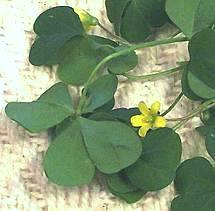
SAFARI
Users
Oxalis Family
Oxalidaceae is a small but widely distributed family of generally sour plants. Most common are the Wood Sorrels, found worldwide, sometimes as troublesome weeds.
Bilimbi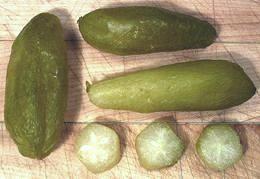 [Tree Cucumber; Averrhoa bilimbi]
[Tree Cucumber; Averrhoa bilimbi]This Southeast Asian tree related to the Carambola is now grown in the tropics around the world, but not in the United States because the winters are too cold even in Florida. The fruit is yellow when ripe and five sided like the Carambola but not to such an extreme degree. It may be from 1-1/2 to 4 inches long, ovoid or nearly cylindrical. The photo specimen on the left was 2.8 inches long, 1.1 inches diameter and weighed 1 ounce. These were shipped frozen from the Philippines and were photographed still frozen because they collapse when thawed. The fruit is at least as sour as a lemon. It's too tart to eat raw
but is used to make jams and beverages. In Costa Rica it's used to
make relishes eaten with rice and beans. In Indonesia it's dried,
smoked and sold as flavoring Asam Sunti, used for the sour flavor in
recipes in that region. It's used fresh for the same purpose in
Malaysia. Bilimbi can be found in the frozen foods section of markets
serving a Southeast Asian population, particularly Filipino.
Star Fruit / Carambola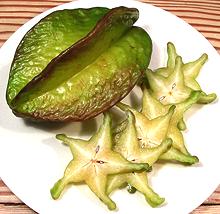 [Coromandel Gooseberry, Kamranga; Averrhoa carambola]
[Coromandel Gooseberry, Kamranga; Averrhoa carambola]
This tree, native to Southeast Asia, has been widely planted in tropical
and subtropical parts of the world. There are two commonly sold varieties,
tart and sweet, which are difficult to tell apart by sight but the sweet
ones tend to have thicker ribs. The main use of Carambola in the U.S. is as
a decorative addition to fruit salads and similar dishes. Carambola is
more cold tolerant than Bilimbi so is grown commercially in South Florida
and in Hawaii. The photo specimen was typical of what we get here in Southern
California, 6-3/4 inches long, 4 inches across and weighed 14-3/4 ounces.
It was very juicy and tart-sweet, a bit more tart than a tart apple but not
at all unpleasant. Details and Cooking.
Oca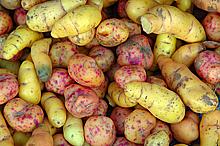 [New Zealand Yam, Oxalis tuberosa]
[New Zealand Yam, Oxalis tuberosa]
This native of the Andean highlands of South America has been
introduced to other parts of the world as an alternative to the
potato. Outside its home range it has been most successful in
New Zealand where a pink variety is grown. Unlike the potato, the
leaves and young shoots of the Oca can be eaten as well as the tubers.
Oca tubers can be eaten raw, lightly cooked or fully cooked and their
response to cooking, from crunchy to soft, is similar to carrots.
After harvest, tubers are often left in the sun for a while which
reduces the oxalic acid content of the skin and sweetens them. This
plant does well in harsh climates and with poor soil, but will only
set tubers in temperate areas where there is a sufficient difference
in day length from season to season. Photo licensed under
GNU Free Documentation License v1.2 or later.
Wood Sorrel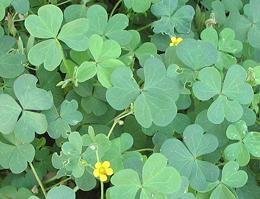 [Oxalis, Oxalis stricta and other Oxallis species]
[Oxalis, Oxalis stricta and other Oxallis species]
A common weed found in moist sunny areas of the garden, oxalis has
almost exactly the same taste as the unrelated
Sorrel. It can be used to spice
up salads but should not be used in large quantity because of the high
oxalic acid content. It should also not be eaten too often, because
oxalic acid can interfere with calcium absorption. There are some
900 species found over most of the world, but the photo specimen is
O. stricta, the common North American weed. Another species,
Redwood Sorrel (O. oregana) native to northern California,
Washington, Oregon and into British Columbia has larger leaves,
larger white or violet flowers and is a little less tart. Many species
with large and decorative flowers are sold in plant nurseries for
garden use. Common Wood Sorrel (O. acetosella) is found in
most of Europe and Scurvy Grass Sorrel, a South American species
(O. enneaphylla), was formerly used by sailors to ward off the
vitamin deficiency disease scurvy.
Bermuda Sorrel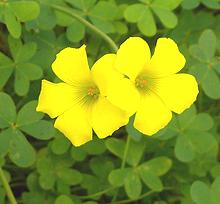 [Bermuda buttercup, African wood-sorrel, Buttercup oxalis,
Cape sorrel, English weed, Goat's-foot, Sourgrass, Soursob, Soursop
(English); Suring (Afrikaans); Oxalis pes-caprae]
[Bermuda buttercup, African wood-sorrel, Buttercup oxalis,
Cape sorrel, English weed, Goat's-foot, Sourgrass, Soursob, Soursop
(English); Suring (Afrikaans); Oxalis pes-caprae]
Native to South Africa, this plant has become a noxious weed in many
regions of the world, including coastal California and especially
Australia. In moderate quantities the foliage is palatable, safe to
eat, and in South Africa used in traditional soups. It is usually
harmless to grazing livestock, but in Australia it grows so profusely
it can be hazardous to them. The root tubers are also edible, raw or
cooked, and if eaten raw in sufficient quantity have been used to
expel tapeworm, and perhaps some other worms.
Photo by MathKnight distributed under license Creative
Commons
Attribution 3.0 Unported
|
Huaceae Family
Huaceae is a small family of just two genera, both native to Central and West Africa.
Country Onion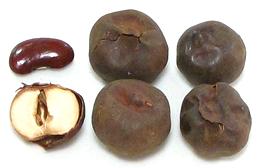 [Afrostyrax lepidophyllus]
[Afrostyrax lepidophyllus]
This medium tree, growing to 65 feet high, has a discontinuous distribution: Ghana, Camaroon, Gabon, northern Republic of the Congo and Democratic Republic of the Congo. All parts of the tree smell strongly of Garlic, actually more like fried garlic. Within its range, the fruit is used as a seasoning spice, usually ground. The tree has medicianal potential, particularly extracts of leaves and bark which have strong antioxidant properties. The photo specimens, from Cameroon, were 0.77 inch diameter with
a 0.73 inch diameter kernel under a very thin brittle skin. They
weighed 12 to the ounce. They were purchased on-line for 2018 US $3.50
/ ounce plus shipping.
|
Elaeocarpus Family
Elaeocarpus is a family South Asian and Southeast Asian fruit bearing trees. there are probably other edible species, but I have insufficient information to write any of them up.
Japanese Blueberry [Shan du ying (China); Horutonoki, Mogashi (Japan); Dampalsu (Korea);
Com trau, Côm cánh trui, côm rung, côm gao,
côm lá to, côm tang, xuong cá (Vietnam);
Elaeocarpus sylvestris]
[Shan du ying (China); Horutonoki, Mogashi (Japan); Dampalsu (Korea);
Com trau, Côm cánh trui, côm rung, côm gao,
côm lá to, côm tang, xuong cá (Vietnam);
Elaeocarpus sylvestris]
This tree is found in much of China, Japan, Korea and Vietnam in
woodlands at elevations of between 1000 to 6500 feet and can grow to
around 50 feet tall. The small fruits of this tree are edible. Oil is
pressed from the seeds but is not used for cooking. The wood rots
easily and is used for growing Shiitake mushrooms. The leaves contain
a substance that has been found potentially useful for treating
radiation induced injury.
Photo by KENPEI distributed under license Creative
Commons
Attribution 3.0 Unported
Ceylon Olive / Jolpai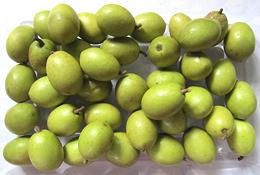 [Jolpai (English, India); Belfoi (Bengali); Veralu (Sinhala); Veralikkai
(Tamil); Kaarakka, Kaara (Malayalam); Jolphai (Assamese); Chorphon
(Manipur); Elaeocarpus serratus]
[Jolpai (English, India); Belfoi (Bengali); Veralu (Sinhala); Veralikkai
(Tamil); Kaarakka, Kaara (Malayalam); Jolphai (Assamese); Chorphon
(Manipur); Elaeocarpus serratus]
Native to Sri Lanka, this tree is found on the Indian Subcontinent as far north as Nepal and Assam, and through much of Southeast Asia, including Indonesia. It is now also seen in East Africa and Florida. The fruits, which are up to 1 inch long, are high in starch and sugar, but low in protein. They are ripe when they fall from the tree, but must be gathered soon. Pickled in various ways, they are a popular street food in Sri Lanka,
but eaten plain they can cause constipation, and thus may be used as a
treatment for diarrhea. In Florida they have been found quite good sliced
and cooked in tomato sauce dishes. The seed kernels are reported to
taste similar to Brazil Nuts, but are difficult to shell.
Photo by Gregorvitch distributed under license Creative
Commons
Attribution 3.0 Unported
Makoknum [Makoknum, Makok (Thai); Spanish Plum; Elaeocarpus hygrophilus]
[Makoknum, Makok (Thai); Spanish Plum; Elaeocarpus hygrophilus]
Native to Southeast Asia, this tree can grow to 80 feet high and
bears clusters of green fruit. These fruit are eaten in Thailand,
Vietnam and probably Burma where it is very common. While the
Internet abounds with photographs of this fruit, I've found nothing
on how it is eaten. Note that both the Thai name Makok and "Spanish
Plum" are also used for the completely unrelated
Spondias dulcis, the
Ambarella or Tahitian Apple. This leads me to suspect these fruits
are used similarly to the much better known Ambarella.
Photo © d0001
.
Maqui [Maqui, Maque (Spanish); Chilean Wineberry;
Aristotelia chilensis]
[Maqui, Maque (Spanish); Chilean Wineberry;
Aristotelia chilensis]
Native to the rainforest of central Chile and extending a little into
Argentina, this small tree, growing to about 20 feet, bears black
berries about 0.20 inch diameter. the tree is cultivated in Chile on
a very small scale, and a little in Spain as well, but most berries
are gathered in the wild. They taste similar to blackberries and are
eaten fresh, dried or made into jams or beverages. They are now being
used as a dietary supplement, being high in antioxidants.
Photo by Morrana distributed under license Creative
Commons
Attribution 3.0 Unported
|
Health & Nutrition
Members of the Oxalis family are made tart by oxalic acid, a substance that inhibits absorption of some minerals by the body, particularly calcium. Oxalic acid is said to contribute to formation of kidney stones and gout but is only one of many contributing factors and probably not a very strong one. Because these vegetables are generally consumed infrequently and in small quantity, the oxalic acid content should not be a significant problem.
